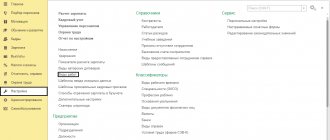Company accounting provides users with reliable information. To generalize it, accounting data is systematized in value terms on synthetic accounts, and a more detailed decoding of information is achieved by maintaining analytical accounting using natural and cost meters, as well as sub-accounts. The accounting structure is subject to a coherent system - a kind of hierarchy of accounts, when information on some accounts becomes the basis for the formation of information on others.
Synthetic accounting is understood as a summing up of accounting information on groups of property, calculations and operations of the company carried out on synthetic accounts according to established characteristics.
Analytical accounting is considered to be accounting maintained on personal or other accounts that combine extensively detailed information about ongoing processes within one synthetic account.
Synthetic and analytical accounting are organized so that the final values of the accounts coincide. The basis for the records on them are the same documents, only in analytics the records are more extensive and detailed, which is due to the greater variety of meters used. Let's figure out which accounts form each informative category.
Synthetic accounting accounts
Users of reporting information often need information of varying degrees of generalization, i.e. both detailed and summary. To obtain indicators of different levels of development, synthetic and analytical accounts are used.
It will be most convenient to start getting acquainted with the accounting structure with synthetic accounts that combine grouped values for all operations of the company. Accounting on synthetic accounts is carried out in monetary terms and using double entry with corresponding accounts.
These include balance sheet accounts: 01 “OS”; 10 "; 51 “Current account”; 43 “Finished products”, 41 “Goods”; 70 “Payroll settlements with personnel”, 80 “UK” and others, forming report No. 1 - balance sheet.
Functions of accounting methods
All information about business transactions must be grouped. All information must be properly organized. This is required for tax audits, convenient storage and obtaining information about processes at the enterprise. For generalized groupings of information, accounts of a synthetic type are used, for specific ones, analytical methods are used.
- A synthetic method is necessary to draw up a balance sheet. It is required to successfully pass all checks.
- The analytical method allows you to quickly obtain all the necessary information on a specific employee. For example, you can see how many sick leave payments have been made to a specific employee.
Question: How to record wages for December (using the example of one employee), accrued and paid on the last working day of December? Salary (official salary) accrued for December amounted to 30,000 rubles. The salary is transferred to the employee's bank account. The income of a tax resident employee on an accrual basis since the beginning of the year has not exceeded the base limits for calculating insurance premiums. For profit tax purposes, income and expenses are accounted for using the accrual method. View answer
Analytical accounting accounts
Analytical accounts are opened in addition to synthetic ones. We can say that analytics generates synthetic accounts, recording information on types of property, calculations and obligations, expressed in total and physical terms. Analytical accounts are used for a detailed description of accounting objects. For example, for account 62 “Settlements with buyers and customers” it is necessary to know not only the total amount of settlements, but also the specific amount of debt for each counterparty and the timing of its occurrence, and for the “Materials” account, competent analytics will indicate the availability, number of units and location of each type of goods and materials.
To detail synthetic accounting accounts, analytical accounts of different structures are used. Thus, to account for inventory items, analytics of a quantitative-total configuration are used, where the balance and dynamics of inventory items are recorded, respectively, in both cost and quantitative terms. Accounting for settlements with personnel regarding wages in terms of their accrual is carried out in labor and monetary terms, and for deductions from wages - exclusively in money.
In analytical accounting, double entry is not acceptable; simple entry is practiced. However, the information accumulated in analytics is more informative. Group analytical data within one synthetic account, opening subaccounts for it if necessary.
Components of accounting
If we talk about the general concepts of synthetics and analytics in accounting, then:
- Synthetic accounting is a generalization of data on the types of property, liabilities and business transactions according to certain economic characteristics. Synthetic accounting is carried out on the main accounting accounts, which are balance sheet.
- Analytical accounting is carried out in personal, material and other analytical accounts. In practice, they group detailed information about a company's assets, business transactions and liabilities within each synthetic account.
But what do these accounting concepts themselves mean?
Subaccounts
Subaccounts serve as an intermediate link between synthetic and analytical accounts. They are opened for a specific synthetic account, and information from one or more analytical accounts can be combined on it. In turn, several sub-accounts can form one synthetic account. This is demonstrated by the table, which shows the structure of synthetic accounting account 90 “Sales” and its connection with analytics and subaccounts:
| Synthetic account | Subaccounts | Analytical accounting |
| 90 "Sales" | 90/1 “Revenue” | Analytics (cards, accumulative statements) for the account are maintained for each subaccount, generating data on revenue, cost, VAT, etc., as well as by type of product, sales regions, directions, based on the interests of the company, broken down by the corresponding subaccounts |
| 90/2 “Cost” | ||
| 90/3 "VAT" | ||
| 90/4 "Excise taxes" | ||
| 90/5 “Export duties” | ||
| 90/9 “Profit/loss from sales” | At the end of the year, all open subaccounts are closed with internal postings to subaccount 90/9 |
Another example is the breakdown of account 10 “Inventory and Materials” into subaccounts, where materials, fuel, packaging are taken into account separately, and cards are created in the warehouse for each type of material, the balances of which are transferred to the corresponding subaccounts of the 10th account, and subsequently the total balance is displayed according to the account.
Analytical accounting chart of accounts
The modern chart of accounts is a multi-level hierarchy, which is built on bundles of accounts and sub-accounts. Depending on the specifics of the enterprise’s activities, the chart of accounts developed for accounting may include a certain number of levels, as well as the required number of sub-accounts opened for each account. In the modern accounting program 1C Enterprise 8, the number of subaccounts and nesting levels available for creation is not limited. The option to create and edit new accounts is available not only to developers, but also to program users. Although the user does not have rights to delete accounts created under the developer's name.
Relationship between analytical and synthetic accounts
Synthetic and analytical accounting accounts are closely related. This relationship is expressed in the fact that the sums of initial balances (debit or credit), turnovers and ending balances for all analytical accounts belonging to one synthetic account are equal to the opening balance, turnovers and balances at the end of the period of this synthetic account.
Thus, synthetic and analytical accounts are interrelated because:
- all transactions are recorded on them based on the same supporting documents and on the same side of the account;
- all accounts take into account homogeneous objects;
- the totals of balances and turnover in the accounts of synthetic and analytical accounting are necessarily equal.
To reflect analytical information, various accounting registers are used - cards, grouping forms, cumulative statements, etc. Combined in subaccounts, the information is verified with the data of synthetic accounts and then reflected in the General Ledger. Often, synthetic and analytical accounting information is combined in one accounting register, for example, an order journal.
The correctness of the entries in the accounts and the preparation of the balance are controlled by balance sheets, which are summary tables that indicate the presence and movement of accounting objects for the period under review.
Moscow State University of Printing Arts
5.
Synthetic and analytical accounting
5.1.
Accounting Meters
Measurements are units of measurement of accounting objects. In accounting, three types of meters are used: natural, labor and monetary (cost). The monetary meter is especially widely used, which makes it possible to have generalized indicators.
Natural meters are designed to take into account objects in their natural and material form. The choice of a meter of this type depends on the physical properties of the objects taken into account: pieces, meters, kg, liters, etc.
Labor meters are designed to record labor costs in man-days, man-hours and are used in accounting to calculate wages for workers. Labor costs are recorded in time sheets.
The monetary measure is a general one; the basis for its calculation is labor and natural measures. The universal cost (monetary) meter allows you to compare and generalize various objects of accounting observation. Only with its help can you reflect the financial result of an enterprise (profit or loss). Financial statements are prepared in monetary terms.
5.2.
Synthetic and analytical accounts
From the point of view of detailing information, accounting accounts are divided into synthetic and analytical. In synthetic accounts, objects of accounting observation are reflected in a generalized form in a monetary measure. Analytical accounts detail the generalized indicators of synthetic accounts and specify the objects taken into account.
Summary and more detailed information is necessary for enterprise management. For example, the administration of an enterprise, in order to pay wages, needs to know how much money is required for this, i.e. have general information about the total amount of wages owed to the collective. It is reflected in the credit of synthetic account 70 “Settlements with personnel for wages”. To pay wages, it is also necessary to know the amount of accrued wages and deductions from it for each specific employee. For this purpose there are analytical accounting accounts.
Accounting carried out on synthetic and analytical accounts is called synthetic and analytical, respectively. The emergence and separation of synthetic and analytical accounting is associated with the name of J. P. Savary (1676).
Synthetic accounts are located on the left side of the Chart of Accounts. Synthetic accounts are called main accounts of the first order. These include, for example, accounts: 01 “Fixed assets”, 04 “Intangible assets”, 10 “Materials”, 20 “Main production”, 50 “Cash”, 60 “Settlements with suppliers and contractors”, 80 “Authorized capital” etc. Based on balances on synthetic accounts, a balance sheet and other forms of reporting are compiled, and an analysis of the financial and economic activities of the organization is carried out.
Synthetic accounts can be simple or complex. Indicators of simple synthetic accounts are not subject to further detail; analytical accounting is not carried out in their development. Examples of simple first-order accounts are accounts: 80 “Authorized capital”, 82 “Reserve capital”, 84 “Retained earnings (uncovered loss)”, 99 “Profits and losses”.
Sub-accounts, which are second-order accounts, can be opened for complex synthetic accounts. In the Chart of Accounts they are located on the right. Thus, subaccounts have been opened for synthetic account 58 “Financial Investments”: 1. Units and shares; 2. Debt securities; 3. Loans provided; 4. Deposits under a simple partnership agreement. On sub-accounts, as well as on synthetic accounts, accounting is carried out in a monetary meter. Subaccounts are not analytical accounts; they detail the synthetic account, dividing it into economically homogeneous groups. Subaccounts are a way of grouping analytical accounts. The list of subaccounts is not strictly mandatory. It only indicates the directions in which the analytical accounting data should be grouped.
Indicators of complex synthetic accounts, when necessary, find their detail in analytical accounting. Analytical accounts present information not only in monetary terms, but also in physical terms. Using analytical accounting data, you can monitor the status of inventories of each type, settlements with each supplier, contractor, employee, etc.
Analytical accounting is inextricably linked with synthetic accounting. Entries in analytical accounting are made on the basis of primary accounting documents (invoices, receipt orders, acceptance certificates, production reports, etc.), and entries in synthetic accounts are made on the basis of a set of analytical accounts opened in the context of synthetic accounts. This means that the total totals of the analytical accounts must be equal to the totals of the synthetic account combining them.
5.3.
Generalization of synthetic and analytical accounting data
Synthetic and analytical accounting are interrelated due to the fact that they are based on the same primary documents and records. Before reporting, all accounting information is first summarized in analytical accounts (turnovers are calculated, balances are displayed), and then synthetic accounts are generated based on the aggregate indicators of analytical accounts. Such a generalization is made in the turnover sheets. The turnover sheet is a way of summarizing accounting registration data in accounting accounts. Turnover statements are compiled at the end of the month on the basis of account data on balances at the beginning and end of the month and turnover for the month. There are turnover statements for synthetic accounting and analytical accounting accounts.
There are two types of turnover sheets for analytical accounting accounts:
- Quantitative-total, in which natural and cost indicators are used;
- Contractual, in which only the cost indicator is used.
Quantitative and total statements are compiled for inventories, finished products, fixed assets and similar accounts. Contract accounts are compiled for current accounts, cash, stock and accounts. Turnover statements for analytical accounting accounts are compiled separately for each synthetic account in the context of which analytical accounting is maintained.
Example. The publishing house produces brochures and books. The publishing house produces fiction, economic literature and guidebooks. Economic literature and guidebooks are published in the form of brochures, fiction - in the form of hardcover books. The following books are published: W. Shakespeare “Comedies” and B. Pasternak “Selections”. Brochures include: “Guide to Spain”, “Guide to the Seychelles”, E. A. Rusakova “Accounting for fixed assets”. The publishing house reflects finished products in account 43 “Finished products” (account 43 is a first-order account). Subaccounts (second order accounts) are opened to account 43 “Finished products”: 43.1 - “Books”, 43.2 - “Brochures”. In the context of subaccount 43.1 “Books”, an analytical account 43.1-1 “Fiction” (third-order account) is opened. If a decision is made to produce, for example, hardcover dictionaries, it will be necessary to include a third-order analytical account 43.1 -2 “Dictionaries” in the Working Chart of Accounts. Further, the analytical accounting contains accounts of the fourth order, which coincide with the names of the published publications: 43.1 -1.1 - W. Shakespeare “Comedies”, 43.1 -1.2 - B. Pasternak “Selected”. In the context of subaccount 43.2 “Brochures”, analytical accounts of the third order are opened: 43.2-1 “Economic literature” and 43.2-2 “Guides”. Thus, 43.2-1.1 - E. A. Rusakova “Accounting for fixed assets”, 43.2-2.1 - “Guide to Spain”, 43.2-2.2 - “Guide to the Seychelles”. These are fourth-order analytical accounts. Schematically, the hierarchy of analytical accounts in the context of synthetic account 43 “Finished products” is as follows:
Rice. 5.1. Scheme of subordination of analytical accounts in the context of synthetic
Let the publishing house print its products at the Tver and Mozhaisk printing plants. In synthetic accounting, to reflect settlements for the printing services provided, account 60 “Settlements with suppliers and contractors” was opened. The publishing house is constructing a production facility with the involvement of the construction organization “Vest”, settlements with which are reflected in account 60 “Settlements with suppliers and contractors”. The publishing house also buys office equipment from Compaq, which are suppliers to the publishing house. Thus, subaccounts 60.1 “Suppliers”, 60.2 “Contractors” must be opened to account 60 “Settlements with suppliers and contractors”. Third-order analytical accounts are opened for subaccount 60.1 “Suppliers”: 60.1-1 “Printing. Analytical accounts of the fourth order detail the accounts of the third order: 60.1-1.1 “Tver Printing Plant”; 60.1 -1.2 “Mozhaisk Printing Plant”; 60.1-2.1 "Hewlett Packard"; 60.1-2.2 Compaq. An analytical third-order account 60.2-1 for the construction organization “West” is opened for subaccount 60.2 “Contractors”.
For analytical accounting accounts opened in the context of synthetic account 43 “Finished products”, a quantitative and total statement is compiled (Table 5.1). For analytical accounting accounts opened in the context of synthetic account 60 “Settlements with suppliers and contractors”, a contract sheet is compiled (Table 5.2).
Synthetic accounting data is summarized in the turnover sheets for synthetic accounts. They come in simple and checkerboard shapes. A simple turnover statement for synthetic accounts is called a balance sheet. The turnover balance contains a list of all synthetic accounts of the Working Chart of Accounts. Each account is assigned a separate line, which indicates the opening balance, monthly turnover and ending balance for this synthetic account. This statement has three pairs of columns. With proper accounting, pairwise equality of the results of these columns should be achieved, namely: the total of debit opening balances should be equal to the total of credit opening balances, the total of debit turnover on synthetic accounts should be equal to the total of credit turnover on synthetic accounts, the total of final debit balances should be equal to the total of final credit balances balance.
Table 5.1. Turnover sheet for account 43 “Finished products”
Table 5.2. Turnover sheet for account 60 “Settlements with suppliers and contractors”
Table 5.3. Turnover sheet for accounting accounts
The equality of the total balances of debit and credit accounts is due to the fact that the total of the debit balances of the accounts shows the monetary valuation of the property (assets) of the enterprise, and the total of the credit balances shows the monetary valuation of the sources of property (liabilities) of the enterprise. The equality of the results of debit and credit turnover on accounts follows from the essence of double entry, in which each business transaction is reflected in both debit and credit accounts in equal amounts.
Pairwise equality of the results of the turnover balance has a great control value. The absence of such equality indicates the presence of errors in the accounts that need to be found and corrected. The turnover balance is important for familiarizing yourself with the state and movement of economic assets and the sources of their formation for the month. The turnover balance data is used in preparing the balance sheet.
The turnover sheet for synthetic chess-shaped accounts is constructed as follows. The numbers of synthetic accounts are recorded horizontally and vertically. Then, from the business transactions journal, the amounts that are reflected at the intersection of the corresponding row and column are transferred to the matrix in accordance with the correspondence of accounts. Debit turnovers are collected in a row, and credit turnovers in a column. Having calculated the total turnover, the final balance is determined: the debit balance is recorded in a row, and the credit balance in a column. In the lower right corner of the matrix, the total amounts of turnover and the initial and final balances are reflected.
Table 5.4. Chess balance
Unlike a simple turnover sheet (turnover balance sheet), a checkerboard turnover sheet contains correspondence accounts and is more complex and cumbersome in structure.
5.4.
Cross-reconciliation of synthetic and analytical accounting data
Synthetic and analytical accounting data are always related by the following equalities:
The amount of the balance at the beginning (end) of the month for analytical accounts is equal to the balance at the beginning (end) of the month for the uniting them
synthetic account;
The sum of the monthly turnover (debit or credit) of analytical accounts is equal to the monthly turnover (debit or credit, respectively)
credit) synthetic account uniting them.
Violation of these equalities indicates an error.
Relationship between account and balance
There is a close relationship between accounts and balance. Each balance sheet item has a corresponding account, except for individual items that reflect data from several accounts.
For example, Raw Materials and Supplies contains balances for several accounts.
Cash - this item summarizes the balances of accounts 50, 51, 52, 55.
Accounts are divided into active and passive in the same way.
The balances of assets and the sources of their formation are shown in the accounts on the same line as in the balance sheet. The sum of the balances for all active accounts is equal to the total of the assets of the balance sheet, for all passive accounts they are equal to the total of the liabilities of the balance sheet.








